Note: If an image ever fails to appear - refresh your page, it really is there
Historical Czech Flags
My interest in Czech Flags comes from the fact that my family was honored to host a foreign exchange student who came from Czechoslovakia, but returned home to the Czech Republic. A fellow exchange student attending the high school where I taught came from Czechoslovakia the same year, but returned to the Republic of Slovakia. The year was 1993, of course, and that year Czechoslovakia peacefully split into two separate countries. Because my exchange student came from the historic town of Liberec, I included some Liberec City flags also.
Flags for countries are a fairly modern development. In medieval times countries and towns didn't have flags, but rulers and families had personal coats-of-arms or shields. Some countries and cities also had coat-of-arms, or arms, that usually had been awarded to them by their rulers. On special festival days, striped "landesfarben" (land colors) whose colors were derived from these arms were displayed on "gonfalons," usually horizontally striped banners hung from crosspieces, that were used as standards or ensigns. Today, we would call these national or municipal (city) flags.
Note: After viewing this page, you might wish to visit "Prague: The City of Flags" for more Czech flags.
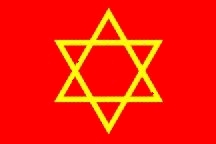
Josefov Flag 1990 This is the modern flag of the Josefov City Borough modeled on the medieval flag. The original 1354 flag was not preserved, but one that is considered to be a close replica was granted to the community in 1648, and is still preserved in the Old Synagogue in Prague. It is much more elaborate than this modern flag, embroidered with borders and curlicues, and including Biblical verses in Hebrew. |
Flag of the Prague Jews c1354
Josefov (Joseph's City) is the Jewish quarter in Prague today. It is named after the Austrian Emperor Josef II. It is a completely new city quarter constructed where the medieval "Jewish Town" was located. Jewish Town was partly destroyed and rebuilt between 1893 and 1913 as part of an initiative to model the City of Prague after the City of Paris. Luckily some of the original synagogues and the ancient graveyard survived this effort. Like most Jewish communities in the Middle Ages, the population experienced horrible massacres in 1096 (during the First Crusade) and in 1389 (when 1,500 Jews were massacred on Easter Sunday), and eventually they were concentrated within a walled ghetto. However, in 1262, King Premysl Otakar II (1230-1278), one of the greatest rulers of Bohemia, granted the community a degree of self-administration.
Evidence indicates that the very first Jewish flag with a six-pointed star dates from this Jewish community of Prague, when they were ordered in 1354 to display a red banner charged with the Star of David, or Solomon's Seal, by Charles IV, the King of Bohemia, and the Holy Roman Emperor. The banner became the symbol of Jewish Town, but was not made official until 1990.
Although the Magen David (Shield of David), the well-known six-pointed star made of two triangles, first appeared according to Jewish tradition on the shield of King David, some historians believe the symbol is not an ancient Jewish symbol at all, but actually originated in Bohemia around 500 years ago. |
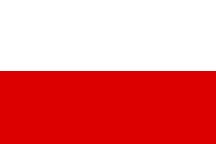
Flag of Bohemia
|
Bohemia Flag 19th Century
The medieval name for the lands covering most of the modern Czech Republic was Bohemia. Bohemia emerged in the late 9th Century, and was a significant regional power during the Middle Ages. It became part of the Holy Roman Empire, and after the fall of the Holy Roman Empire, Bohemia became part of the Austrian Empire and finally part of Austria–Hungary. Following the collapse of the Austro-Hungarian Empire after World War I, the independent Republic of Czechoslovakia was created in 1918. This new country incorporated the regions of Bohemia, Moravia, Silesia, and Slovakia.
Since 1253, the official state colors of Bohemia have been white and red. In the 15th century, they were established on white and red cords attaching seals to documents issued by the King of Bohemia. After the royal title of Bohemian kings passed to the Austrian Emperors, the royal Bohemian symbols (but not flag, that did not exist yet) were suppressed. The Bohemian flag shown here was based on the colors of the coat-of-arms of the Bohemian Landesfarben in the Hapsburg Empire. During the first half of the 19th century, provincial banners and flags in Landesfarben colors derived from their coat of arms became widespread in Bohemia. |
Although the yellow-red flag is identical to the modern Prague City Flag, it is not related. The colors of the flag are simply "coincidental" and based on the heraldic rules used when making flags from the colors of coat-of-arms. 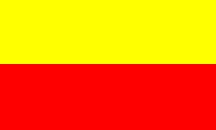
Flag of Moravia
(flag favored by German population)

Flag of Moravia
(flag favored by Czech population)
|
Moravia Flag 19th Century
Moravia is today located in the eastern part of the modern Czech Republic. During the 9th Century, however, it was an independent kingdom called "Great Moravia" (830-896). It was overrun by the Magyars in 896, reconquered by Bohemia in 1029, and in 1849, it became part of Austria. In 1918, it became a province of Czechoslovakia.
In 1938, all of Silesia and some areas in north and south Moravia were seized as part of the German Sudetenland. The remainder of Moravia joined with Bohemia in the German Protectorate of Bohemia-Moravia between 1939 and 1945. In 1945 both parts of Moravia were once again reunited as part of Czechoslovakia and since 1990 has been part of the Czech Republic.
Within the Austro-Hungarian monarchy, official flags were only those hoisted by the monarchy or ruling dynasty. Individual states could not use colors derived from their arms and transformed to the gonfalon banners. Very often, the display of their "landesfarben" (land colors) in Bohemia and Moravia was punished by the Austrian authorities as a symbol of separatism. Even so, some patriots chanced the legal punishments as signs of their of national pride.
Therefore, although the Moravia did not have any official flag, there were land colors (Landesfarben) that were associated with the province. The German population living in Moravia preferred a yellow-red combination that is based on the conquest of Moravia by Emperor Friedrich IV. The
Czech population of Moravia gave priority to the older white-red combination.
From mid-19th century, white and red Moravian flags (identical to the Bohemian ones) were generally accepted as a Czech national symbol. |
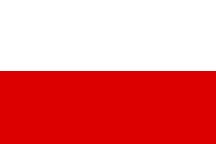
Flag of Czechoslovakia 1918
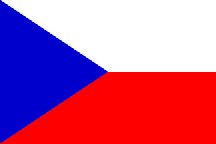
Flag of Czechoslovakia 1920
|
Czechoslovak Republic Flags 1918-1939
The Republic of Czechoslovakia was a sovereign state in Central Europe which existed from 1918, when it declared its independence from the Austro-Hungarian Empire, until 1992. From 1939 to 1945, Czechoslovakia was forced to divide and was partially incorporated into Germany. During this occupation the Czech government-in-exile continued to exist, while Slovakia was an independent satellite of Germany.
The first provisional historical flag of Czechoslovakia was the plain horizontal white-over-red striped flag of Bohemia. As stated, Czechoslovakia was proclaimed independent on October 28, 1918, as part of the break-up of the Austro-Hungarian empire during the peace negotiations after World War I. Because of this, October 28, is still a public holiday in the Czech Republic.
In 1920, a blue triangle on the hoist was added to the Czechoslovakian flag. The flag was changed to make it look different from the Polish flag, and the blue triangle was added because the color blue was a traditional Slovakian color. The triangle was used because it resembled the Greek summa and stood for the unity of Bohemia and Slovakia. This design stayed in use until 1939, then after World War II, it was restored again and used by the Czechoslovak Republic between 1945 and 1990, and later adopted by the Czech Republic since 1993.
|
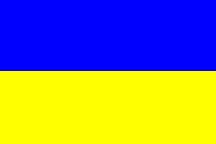
Flag of Carpatho-Ukraine
|
Carpatho-Ukraine Flag 1939
Before 1939, Czechoslovakia consisted of a three parts, the third part was called Subcarpathian-Ruthenia. In 1938, the Sudetenland was annexed by the Third Reich. What remained of Czechoslovakia seemed to be up for grabs and Slovakia and Subcarpathian-Ruthenia both attempted to declare their independence. In 1939, Germany annexed the remainder as the "Reichsprotektorat" (Bohemia and Moravia), while Hungary annexed Subcarpathian-Ruthenia and some more parts of Slovakia, and Poland annexed the Teschen area. What little remained declared its independence as Carpatho-Ukraine.
In 1945, after World War II, Czechoslovakia was restored, except for Carpatho-Ukraine which became part of the Ukrainian SSR.
|
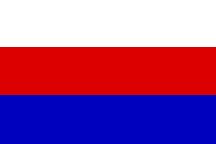
Flag of Bohemia-Moravia
|
Protectorate of Bohemia-Moravia Flag 1939-1945
The Protectorate of Bohemia and Moravia (Reichsprotektorat Böhmen und Mähren) was the majority ethnic-Czech protectorate which Nazi Germany established in the central parts of Bohemia, Moravia and Czech Silesia. It was established in 1939 by proclamation of Adolf Hitler from Prague Castle following the declaration of establishment of the independent Slovak Republic. Bohemia and Moravia were autonomous Nazi-administered territories which the Nazi government considered part of "Greater Germany."
The old Czechoslovak State colors were used as a new flag of the Protectorate of Bohemia and Moravia. Of course, this all came to an end with the surrender of Germany to the Allies of World War II in 1945.
|
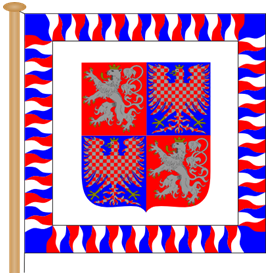
Bohemia-Moravia President (Obverse side)
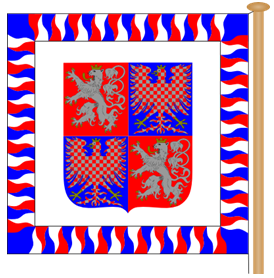
Bohemia-Moravia President (Reverse Side)
|
Standard for the State President
Protectorate of Bohemia and Moravia 1939-1945
Bohemia and Moravia were autonomous Nazi-administered territories which the German government considered part of the Greater German Reich. It was established on March 15, 1939 by proclamation of Adolf Hitler from Prague Castle. Although absolutely controlled by means of a German "Reichsprotektor" (the first was Konstantin von Neurath), it was found useful to have a kind of President for the so called "Protectorate". The former president of the Czech rumpstate, Emil Hácha, remained as technical head of state with the title of State President. Although he protested against the German policies and Germanization of former Czechoslovakia, that was to little effect. Nevertheless, Hácha continued to hold the position of State President until the end of the war, when he was arrested on May 14, 1945. He died on June 26, 1945 under mysterious circumstances.
Although Bohemia and Moravia were controlled by Nazi Germany, the symbols of the former Czechoslovakian republic were still in use. Only on July 12, 1939, Reichsprotektor von Neurath wanted to establish new symbols of the Protectorate, including a new standard for the President. He ordered to set up new symbols within three days. After all, being under deadline pressure, it was missed to illustrate the new standard, which was designed by the heraldist Karel von und zu Fürst Schwarzenberg. Instead, there was an incomplete description. It was defined that the standard was a square of white, containing the Greater arms of Bohemia and Moravia. Entirely omitted was the description of the border of the standard. The famous vexillogist and heraldist, Ottfried Neubecker, illustrated the standard in his splendid "Flaggenbuch" from 1939. Obviously he was not sure about the border of the standard and thought it consisted of rectangles in the Czech colors White, Red and Blue. In this way he illustrated the standard. It was one of his very few mistakes he made in this book. Later it turned out, that Fürst Schwarzenberg chose the traditional border of the Czech Presidents standards, which was a border of flames alternately in the colours White, Red, Blue.
The back (reverse) of the standard was the same as the front (obverse), but of the border, which was a "through and through" (mirrored) image of the front side. |
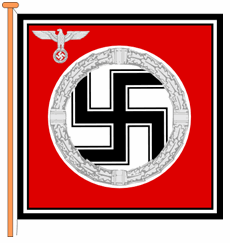
Reichsprotektor Standard/Banner
|
Standard of the German Reichsprotektor of Bohemia and Moravia
1939-1945
At first Czechoslovak President Emil Hácha remained as technical head of state with the title of State President, but German officials manned departments analogous to cabinet ministries, and small German control offices were established locally. A kind of German "special deputy" of the Führer called the Reichsprotektor of Bohemia and Moravia held all real power. The Gestapo assumed police authority. Jews were dismissed from the civil service, political parties were banned, and many Communist Party leaders fled to the Soviet Union. Eventually, President Hácha was arrested and died under mysterious circumstances in prison.
SS-hardliner Reinhard Heydrich was appointed Deputy Reichsprotektor of Bohemia and Moravia. Under his authority Prime Minister Alois Eliáš was arrested and later executed, the Czech government was reorganized, and all Czech cultural organizations were closed. The Gestapo indulged in arrests and executions. Heydrich, himself, was killed by a Czech hit squad flown in from London in 1942, but his successor ordered mass arrests and executions and the destruction of the villages of Lidice and Ležáky. |
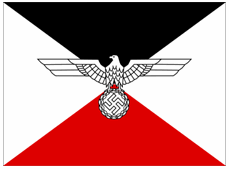
Wehrmacht Adviser to the
Reichsprotektor's Car Flag
|
Car Flag of the Wehrmacht Military Adviser to the Reichsprotektor
1939-1945
The car command flag was similar to that of a Commanding General of the Army with the difference of an added National Eagle that was placed in the center of the flag in white. The second flag was only used as vehicle flag.
For the Czechs of the Protectorate of Bohemia and Moravia, German occupation was a period of brutal oppression. Czech losses resulting from political persecution and deaths in concentration camps totaled between 36,000 and 55,000. The Jewish population of Bohemia and Moravia (118,000 according to the 1930 census) was virtually annihilated. |
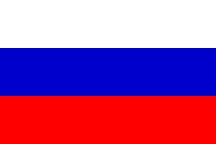
Flag of Slovakia
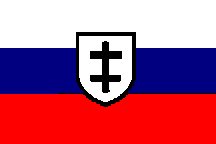
Slovakian State War Flag
|
Slovakian Flags 1939-1945
Slovakia seceded from Czechoslovakia in 1939 and allied with Hitler's coalition. The government of the First Slovak Republic, led by Jozef Tiso and Vojtech Tuka, became a puppet regime of Germany. Most Jews were deported from the country and taken to Nazi concentration camps during the Holocaust, although thousands of Jews remained to labor in Slovak work camps in Sered, Vyhne, and Nováky. President Tiso, using his presidential powers, has been credited with saving as many as 40,000 Jews during the war, although a total of 75,000 died in the Slovakian concentration camps.
After it became clear that the Russian Red Army was going to push the Nazis out of the eastern and central Europe, an anti-Nazi resistance movement launched a fierce armed insurrection, known as the Slovak National Uprising, in 1944. A bloody German occupation and a guerrilla war followed.
During World War II the "Slovenská Republika" used this flag as their national flag. They used the same flag charged with a black two-armed cross on a blank white shield with a black margin as their Slovakian State and War Flag.
|
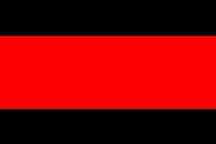
Sudetenland Flag
|
Sudetenland Czech Republic Flag 1938-1945
The Sudetenland, the historical region near border between Czechia and Germany, was settled by Germans and from 1938 to 1945 was connected to Hitler's Third Reich. The Sudeten Germans (Sudetendeutschen) used the colors black-red-black, which date back from the republican symbols of the national convention in Frankfurt, on their tricoloured flag.
This flag was used mainly by the Sudetendeutsche Landsmanschaft (Union of Germans), a large group of Germanic refugees who had to flee from Czechia to Germany after World War II.
|
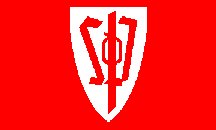
Sudeten German Party Flag
|
Sudeten German Party Flag (SDP) 1933
The "Sudetendeutsche Partei," led by Konrad Henlein was not the Nazi party in Sudetenland. It was a national Czechoslovakian far-right political party that tried to pressure the Czechoslovakian government into allowing the German population of the Sudetenlan to join with Germany.
In 1933, Henlein issued a proclamation demanding the cession of the Sudeten-German territory to Germany. The government responded by suspended his party for treasonable activities and Henlein fled to Germany to escape arrest.
|
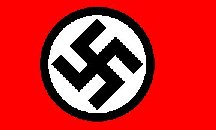
Sudeten German Party Flag
|
Sudeten German Party Flag 1939
The failure of the Sudeten German Party's first attempt resulted in discontent and strong support among some of the Czechoslovakian minorities for a complete break from Czechoslovakia. Adolf Hitler took advantage of this opportunity and, supported by the exciled Konrad Henlein and his Sudeten German Party, gained the largely German speaking Sudetenland through the 1938 Munich Agreement.
The flag of the Sudeten Deutsche Partei was changed after the German occupation to the German swastika flag, but with a black border around the white disc.
|
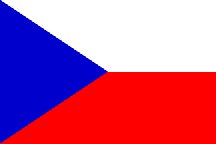
Czech Republic Flag 1993
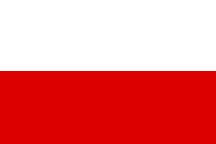
Czech Republic Flag 1990
|
Czechoslovak Republic Flag 1945-1990 (Communist controlled)
Czech and Slovak Federal Republic Flag 1990-1992
Czech Republic Flag 1992-present
In 1948, the Communist controlled Czechoslovak Republic was proclaimed, and was later in 1960 renamed the Czechoslovak Socialist Republic. In reality, all the Czech had done was merely to exchange one totalitarian invader for another.
In 1989, however, Czechoslovakia established an independent liberal democracy through the peaceful "Velvet Revolution," which they renamed the Czech and Slovak Federal Republic in 1990. The Constitution of 1990 set up the Czech Lands and Slovakia as two equal states. Each was to have its own arms, seal, flag and anthem. In 1993, the country divided physically into its two parts - The Czech Republic and Republic of Slovikia. Since 1990, the Czech Republic has gone through successful economic reforms and privatizations, with the intention of creating a capitalist economy.
The new Czech Republic at first adopted their traditional Bohemian flag of white over red, but two years later, in 1993, added the blue triangle at the hoist thus reclaiming the flag of Czechoslovakia for their own. Since most Czechs had considered the Czechoslovak flag their flag for more than 70 years, the 1990 flag was never actually used much, and the addition of the triangle almost went unnoticed by the general population who had basically continued to use the old Czechoslovak flag anyway.
|
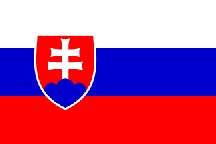
Slovakia Flag
|
Republic of Slovakia Flag 1992-present
In 1993, Czechoslovakia split into the Czech Republic and Slovakia. The Slovak Republic used their traditional plain tricoloured flag dating back to 1848 with the addition of their new coat-of-arms, which is a white cross of Lorraine on a blue mount composed of three hills, on a red background. The new Slovak coat-of-arms, based on the existing historical patterns, was designed by the painter Ladislav Cisarik in 1993. The official interpretation is that the Lorraine cross symbolizes the three important saints, St. Benedict, St. Constantine and St. Method.
Like the Czech Republic, the less industrialized Slovakia is still going through economic and social reforms trying to create a healthy capitalist economy.
|
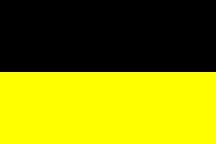
Prague City Flag c1622
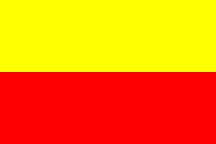
Prague City Flag c1886
|
Historic City of Prague Flags
In 1784, the Austrian Emperor Josef II by Imperial decree incorporated the four separate towns of Prague ( Old Town, New Town, Lesser Town and Hradschin-Castle ) into one city ruled by a single Magistrate. The Magistrate offices were located in the Old Town hall and the arms and flag of Old Town became those of a new capital. The Old Town flag then consisted of two horizontal stripes, black and yellow, which were the colors of the municipal arms in 1622. Unfortunately, they were identical with colors of the Habsburg dynasty which made the Prague "landesfarben" not very popular among Czech citizens.
In 1886, the Municipal Council asked the painter B. Wachsmann to paint new municipal arms, colors and seals for Prague, which he did making the new colors of Prague yellow and red. Since that time, a horizontally divided flag of yellow and red has been considered the official municipal flag of Prague. The new flags in those colors became symbols of Prague and were first used extensively for the Jubilee Exhibition of 1891.
This flag is sometimes confused with the traditional flag of Moravia. The colors used on the flags are simply "coincidental" and based on the heraldic rules used when making flags from the colors of coat-of-arms. Other than the colors, they are not related.
The City of Prague is actually made up of almost 100 small towns that were absorbed as the city grew. Today, the towns have become districts, each with their own unique flag. ( Click here to find out more about "Prague: The City of Flags" )
|
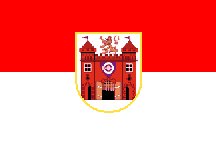
Liberec City Flag 1978
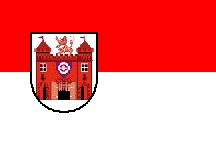
Liberec City Flag (variant)
|
Historic Flags of the City of Liberec
Liberec is a city in the north of the Czech Republic with a population of 100,000 inhabitants. This makes it the sixth largest city in the Czech Republic. In the Middle Ages it was famous for its textile industry and glass production. In 1657, Liberec was granted a coat-of-arms by the Holy Roman Emperor Rudolph II. It is described as "Argent two towers gules with gates, united by the embattled wall of the second." The escutcheon with wheel is that of the ruling von Redern family at the time.

|
|
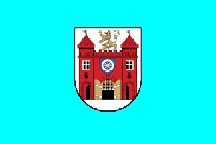 |
| City of Liberec Flag 1906-1920 |
|
City of Liberec Flag 1960-1978 |
Two different versions of the modern flag (shown at the left) with their coat-of-arms are reported in use. One with the arms centered and one with the arms closer to the hoist.
|
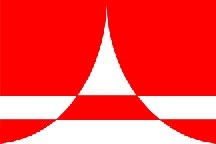
Ješted Mountain Flag
|
Ješted Mountain Flag 2008
Ješted is a 1012 meter-high mountain near Liberec in the Czech Republic. On its summit is the Ješted Tower restaurant, hotel, ski resort, and television tower. It is reachable by road and the special Ješted cable car. The unusual cone-shaped hotel and TV transmitter attempts to architecturally extend the silhouette of mountain. It was designed by Karel Hubáèek in 1973 and considered a jewel of modern architecture and a symbol of the City of Liberec.
It is unusual for a mountain and building to have a flag, but Ješted does. The flag has a red and white check board image of the famous building on it. The flag of the Ješted hotel and broadcaster was proposed in 2008 by Josef Hubka, a member of the Board of the Czech Vexillological Society.
|
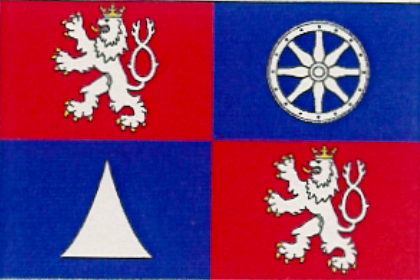
Liberec Regional Flag
|
Liberec Regional Flag 2000
The Regional Administration Act of 2000 authorized the Czech Republic's regions to have both a coat-of-arms and a flag. The flag designs are proposed by the regional governments, then approved by the Chairman of the Czech House of Deputies.
The Liberec Regional Flag is quartered red and blue. In the red first and fourth quarters is the Bohemian lion. The silver wheel of the Redern family is in the second quarter, while the fourth quarter has a stylised white outline of Jested Mountain. The Liberec Regional Flag designer was Jan Tejkal, a member of the Vexillological Club of Prague. |
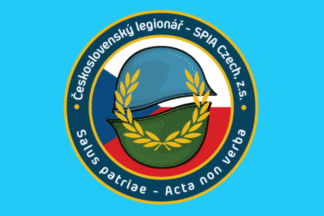
Czechoslovak Legionary
Association Flag
|
Czechoslovak Legionary Association
Ĉeskoslovenská legionářská asociace
The Czechoslovak Legionary Association's mission is to unite Czech and Czechoslovak veterans from both world wars with modern Czech veterans who were involved in more recent conflicts. The association's goals include: peace preservation, supporting humanitarian and democratic traditions, Czech patriotism, education, and veterans' rights.
The Czechoslovak Legionary flag is a light blue flag with the association's logo in the center. The circular logo depicts the Czech flag overlaid with two helmets (the upper helmet, right sided up, a dark cyan blue and the lower helmet, upside down, a dark green), both overlaid with golden laurels. The flag is surrounded by a navy colored ring, edged in gold, bearing the words Ceskoslovenský Legionár - SPIA Czecha, z.s. ("Ceskoslovensk Legionary - International Soldiers of Peace Association, Czech Section") on top and Salus patriae - Acta non verba ("For the good of the fatherland - Actions, not words") on the bottom. |
- My thanks to Željko Heimer, Jaroslav Martykán, and Kryštof Huk for their invaluable help on this page -
| Top of Page | also see "Prague: The City of Flags" |
|